Lallart M. Ferroelectrics: Characterization and Modeling
Подождите немного. Документ загружается.

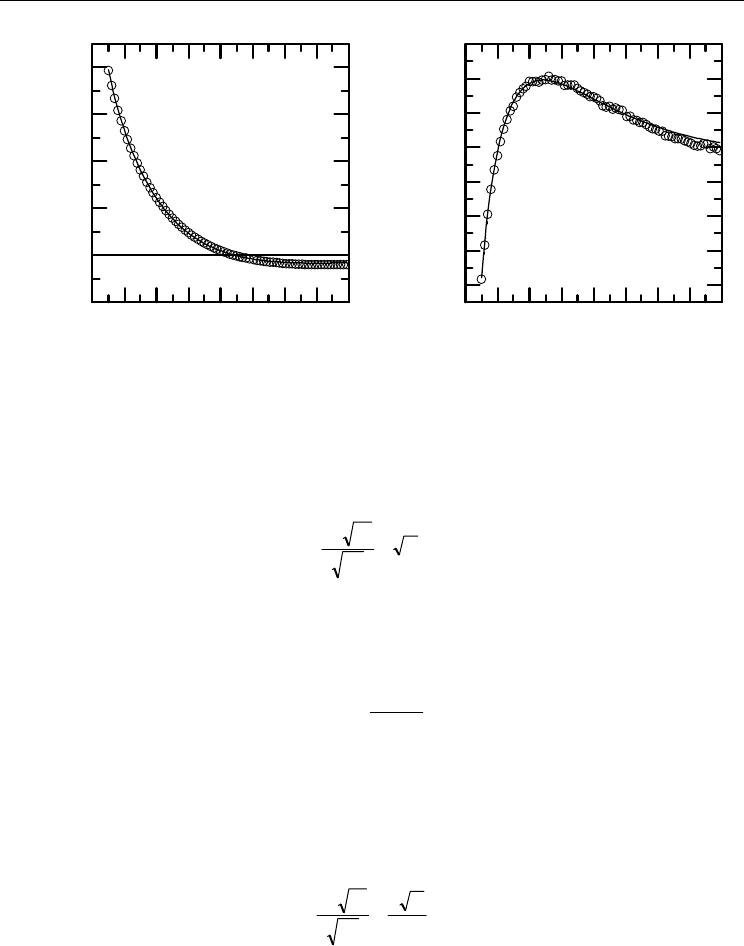
Characterization of Ferroelectric Materials by Photopyroelectric Method
289
0 1020304050607080
-0.05
0.00
0.05
0.10
0.15
0.20
0 1020304050607080
0.92
0.94
0.96
0.98
1.00
1.02
1.04
1.06
Normalized phase (radians)
Frequency (Hz)
Normalized amplitude
Frequency (Hz)
Fig. 4.1 Normalized signal’s phase and amplitude obtained with a 510µm thick LiTaO
3
film
and water as substrate (open circles: experimental data, solid line: best fit).
The phase and amplitude of the signal contain both information about the thermal
diffusivity and effusivity of the ferroelectric material. From analytical point of view, the
phase goes to zero for a frequency f
0
which verifies the relationship:
π
α
=
p
p
fL
0
. (4.1)
In the experiment described before, f
0
= 44.2 Hz leading to a thermal diffusivity of 1.53 10
-6
m
2
.s
-1
for LiTaO
3
. This value can be then introduced in equation (2.12) to extract R
sp
values
and finally the thermal effusivity of LiTaO
3
:
1
1
s
p
ps
s
p
R
ee
R
−
=
+
(4.2)
Knowing the thermal effusivity of water used as substrate (e
s
=1580 W.s
1/2
.m
-2
.K
-1
), the
average value of the calculated thermal effusivity is e
p
= 3603 W.s
1/2
.m
-2
.K
-1
. A similar
procedure can be adopted to extract the thermal parameters from the amplitude of the
signal. The frequency f
1
corresponding to the maximum of the amplitude should verify the
relationship (see Eq. 2.13):
4
3
1
π
α
=
p
p
fL
(4.3)
Fig. 4.1 indicates that the amplitude has a maximum for a frequency f
1
=25.3Hz,
corresponding to a value of 1.56 10
-6
m
2
.s
-1
for the thermal effusivity of LiTaO
3
. By inserting
this value in Eq. (2.13) one can extract the value of R
sp
and, using Eq. (4.2), calculate the
thermal effusivity of the ferroelectric sample. From data of Fig. 4.1, one finds e
p
= 3821
W.s
1/2
.m
-2
.K
-1
.
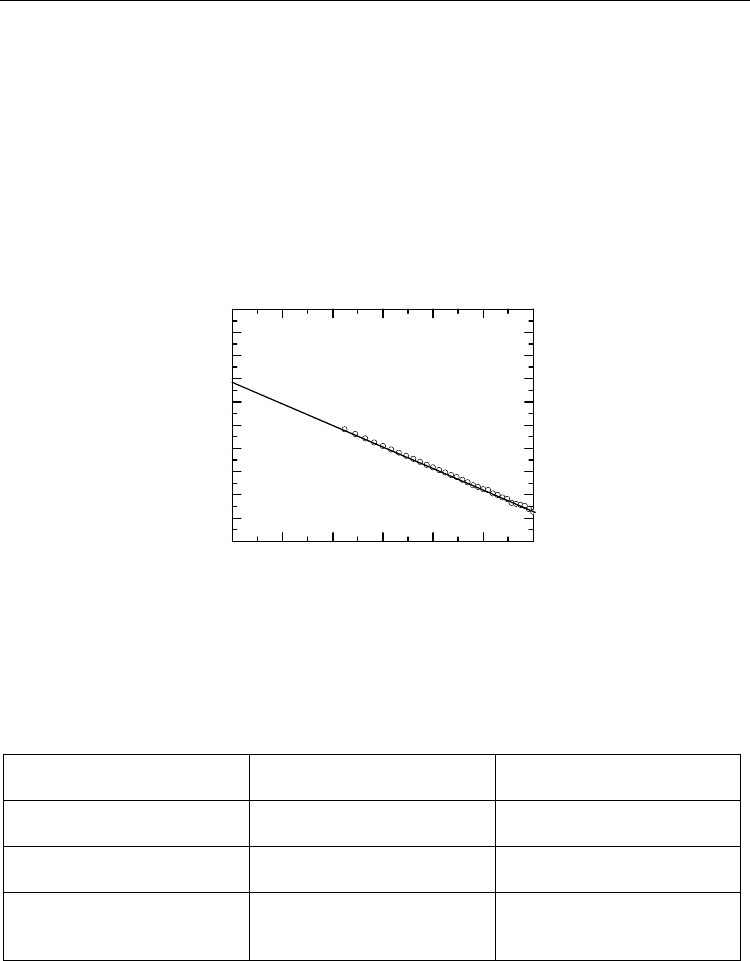
Ferroelectrics - Characterization and Modeling
290
A simple comparison of Eqs. (4.1) and (4.3) indicates that f
1
is theoretically proportional to f
0
by
a ratio 16/9. This criterion can be used to estimate the accuracy of the experimental results. For
example, in the experiment described before, one finds a ratio of 1.74 between f
1
and f
0
, to be
compared to the theoretical value of 16/9
)78.1(≈ . Another way to check for the validity of
the experimental results is to combine the phase and the amplitude of the signal. Considering
the model described by Eq. (2.11), a plot of the modulus of the complex quantity (1-V
n
) as a
function of the square root of frequency should display a line whose slope gives the value of
the thermal diffusivity of the sample; the extrapolation of the curve to zero frequency leads to
the value of the thermal effusivity. Such a calculation has been performed for the experimental
data shown in Fig. 4.1 and the result is represented in Fig. 4.2.
0123456
-4,0
-3,5
-3,0
-2,5
-2,0
-1,5
-1,0
-0,5
0,0
0,5
1,0
ln(|1-V
N
|)
f
1/2
(Hz
1/2
)
Fig. 4.2 Plot of the logarithm of |1-V
n
| as a function of square root of frequency, for data of
Fig. 4.1.
Fig. 4.1 indicates that the model is valid for high enough frequencies. The linear fit of the
data leads to values of thermal parameters in agreement with previous calculated ones, as
reported in table 4.I.
Procedure
Thermal diffusivity
(x10
-6
.m
2
.s
-1
)
Thermal effusivity
(W.s
1/2
.m
-2
.K
-1
)
Zero crossing (phase)
Maximum (amplitude)
1.53
1.56
3821
3603
Combination of amplitude
and phase (linear fit)
1.58 3886
Non linear fit
Phase
Amplitude
1.54
1.53
3688
3718
Table 4.I Comparison of values of thermal diffusivity and effusivity, obtained with various
procedures, for a 510µm thick LiTaO
3
single crystal.
The previous results show that the proposed model allows the determination of the thermal
parameters from a frequency scan of the PPE signal generated by the ferroelectric sample

Characterization of Ferroelectric Materials by Photopyroelectric Method
291
itself. There are several approaches giving similar results (3% to 5% maximum difference for
values of thermal diffusivity and effusivity, respectively). However, it should be pointed out
that the results obtained with the phase as source of information are often more reliable due
to the fact that the amplitude of the signal can be affected by light source’s intensity stability
as well as by the optical quality of the irradiated surface. Additionally, the frequency
dependence of the amplitude around maximum is rather smooth, and the maximum value
difficult to be located exactly.
At the end of this section, we have to mention that the theoretical results have been obtained
without any hypothesis on the nature of the ferroelectric material used as pyroelectric
sensor. The experimental results were obtained on LiTaO
3
crystals, but a similar procedure
can be carried out for any type of ferroelectric material, as PZT ceramics, polymer films
(PVDF, PVDF-TrFE) and even liquid crystal in S
C
* ferroelectric phase. In the next section this
last particular case will be described.
4.1.2 Thermal parameters of a liquid crystal in Sc* ferroelectric phase.
In this subsection the procedure described in the previous section has been extended to the
study of a ferroelectric liquid crystal (FLC). In chiral smectic S
C
* phase of FLCs, molecules are
randomly packed in layers and tilted from the layer normal. Each smectic layer possess an in
plane spontaneous polarization which is oriented perpendicularly to the molecular tilt. The
direction of the tilt plane precesses around an axis perpendicular to the layer planes so that a
helicoidal structure of the S
C
* is formed. In this helicoidal structure, the S
C
* phase doesn't
possess a macroscopic polarization. When it is confined in thin film between two substrates,
which are treated so that a planar alignment is imposed on the molecules at the surfaces, as
used in surface stabilized FLC (SSFLC) devices (Clark & Lagerwall, 1980; Lagerwall, 1999), the
smectic layers stand perpendicular to the surfaces and the helix can be suppressed if the LC
film is sufficiently thin. This results in two possible states where the orientation of the
molecules in the cell is uniform. The polarization vector in these two states is perpendicular to
the substrates but oriented in the opposite direction. In both configurations the S
C
* film
develops a macroscopic polarization, and consequently, a pyroelectric effect of the film can be
obtained when it is submitted to a temperature variation. We used the LC film as a
pyroelectric sensor and we carried out the procedure described in section 4.1.1 to determine
the thermal diffusivity and effusivity of the S
C
* mesophase.
The ferroelectric liquid crystal (FLC) used in this study was a mixture FELIX 017/000 from
Clariant Inc. (Germany). Its phase sequences and transition temperatures (in°C) are: Crystal
-26 S
C
* 70 S
A
* 75 N* 84.5 I. The sample cell was prepared using a pair of parallel glass
substrates. One of the substrates was metallised with gold. It acts as a light absorber and
generates a heat wave penetrating into the sample. The other substrate was coated with a
transparent electrode of indium-tin oxide in order to control the alignment of the FLC by
means of polarized optical microscopy. The gap of the cell was set by a 13 μm thick spacers
of PET, and the electrode area was 5
×
5mm
2
. The two plates were spin-coated with
PolyVinylAlcohol (PVA) and then rubbed in parallel directions for the FLC alignment. The
FLC was inserted by capillary action in the cell in its isotropic phase, then slowly cooled into
S
A
* and S
C
* in the presence of an AC electric field to achieve uniform alignment of the
smectic layers. The sample cell was then observed at room temperature by means of
polarized optical microscope. It was found that the LC cell exhibits a uniform texture, and
we have not observed any “up” and “down” polarization domains coexistence.

Ferroelectrics - Characterization and Modeling
292
In the previous section, the studied pyroelectric sample was a solid material and the
normalizing signal was obtained by using air as substrate. Here, the studied material is
fluid (this is the case of the liquid crystal material), the normalizing signal is then obtained
using another solid pyroelectric material with air as substrate. In this case the normalized
signal is given by:
0
1
(1 (1 )exp( ))
ns
ppp
K
VRL
K
σ
=−+ −
(4.4)
K
0
/K
1
is a real factor independent of the modulation frequency and represents the limit value
of the normalized amplitude at high frequency. This factor does not affect the analysis
carried out on Eq. (2.11) for the determination of the thermal parameters. The frequency of
the zero crossing of the normalized phase (Eq. 3.1) or the frequency corresponding to the
normalized amplitude maximum (Eq. 3.3) allows the determination of the absolute value of
the thermal diffusivity of the sample. The thermal effusivity can also be calculated from the
normalized amplitude once α
p
is obtained and the quantity K
0
/K
1
is determined from the
value of the normalized amplitude at high frequency. The frequency behaviour of the
normalized phase of the PPE signal is shown in Fig. 4.3.a
10 100 1000
-0.1
0.0
0.1
0.2
0.3
0.4
0.5
0.6
0.7
0.8
Normalized phase (radians)
Frequency (Hz)
10 100 1000
1
Normalized amplitude
Frequency (Hz)
(a) (b)
Fig. 4.3 Experimental frequency behaviour of the normalized phase (a) and the normalized
amplitude (b) obtained for the liquid crystal at room temperature, in the S
C
* phase.
As expected from the theory, the phase goes to zero, for a frequency f
0
= 354 Hz. Once f
0
is
determined, equation 4.1 is used to obtain the thermal diffusivity of the ferroelectric liquid-
crystal sample. A value of α
p
= 1.90 10
−8
m
2
s
−1
was found.
The normalized amplitude of the PPE signal (Fig. 4.3.b) shows a maximum for the frequency
f
1
= 191 Hz. The value of
α
p
calculated by using Eq. (4.3) is
α
p
= 1.82 10
−8
m
2
s
−1
, denoting
that the values of the thermal diffusivity obtained independently from phase and amplitude
are in good agreement.
The effusivity e
p
is calculated from the signal phase by using Eqs. (2.12) and (4.2) and taking
from the literature the value of the thermal effusivity of glass (e
s
= 1503 Ws
1/2
m
−2
K
−1
). The

Characterization of Ferroelectric Materials by Photopyroelectric Method
293
mean value of e
p
is then calculated in a range of frequencies for which the sample is
thermally thick; e
p
is found to be 340W s
1/2
m
−2
K
−1
.
The same procedure carried out for different temperatures allows for example the
investigation on the temperature dependence of the thermal parameters of the smectic S
C
*
phase and near the S
C
*-S
A
* transition of FLC materials. However, the use of frequency scans
together with temperature scanning procedures can be time consuming when working in
the vicinity of critical regions. In the next section, we will introduce a procedure avoiding
such frequency scans.
4.1.3 The temperature dependence of the thermal parameters
In the previous section, it has been shown that a frequency scan of the amplitude and/or the
phase of the photopyroelectric signal allows the direct measurement of the room
temperature values of thermal diffusivity and effusivity of a ferroelectric material and
consequently, the calculation of its heat capacity and thermal conductivity. In the following
we will describe a procedure useful to study the temperature evolution of these thermal
parameters without involving any frequency scan.
Considering the modulus A and the argument
φ
of the complex quantity 1-V
n
, and using
Eq. (2.11), one has:
)exp()1(
ppsp
LaRA −+=
and
pp
aL
φ
=
The expression for the thermal diffusivity and thermal effusivity is obtained as a function of
A and
φ
as:
2
2
φ
π
α
fL
p
p
=
(4.5)
1
)exp(
−
−
=
φ
A
R
sp
(4.6)
A and
φ
are calculated from the phase Θ and the amplitude |V
n
| of the PPE signal, using
the relationship:
2
12 cos
nn
AV V=+− Θ
(4.7)
Θ−
Θ
=
cos1
sin
arctan
n
n
V
V
φ
(4.8)
We have applied this procedure to find the temperature dependence of thermal parameters
of a 510µm thick LiTaO
3
single crystal, provided with opaque electrodes and using ethylene
glycol as substrate. The temperature range was 25°C-70°C. During the experiment, the
modulation frequency was 7.2Hz. The signal of the LiTaO
3
alone (without substrate) was
recorded in the same conditions for normalization purposes. The normalized amplitude and
phase are represented in Fig. 4.4. The thermal diffusivity and thermal effusivity, calculated
from these data, are displayed in Fig. 4.5.
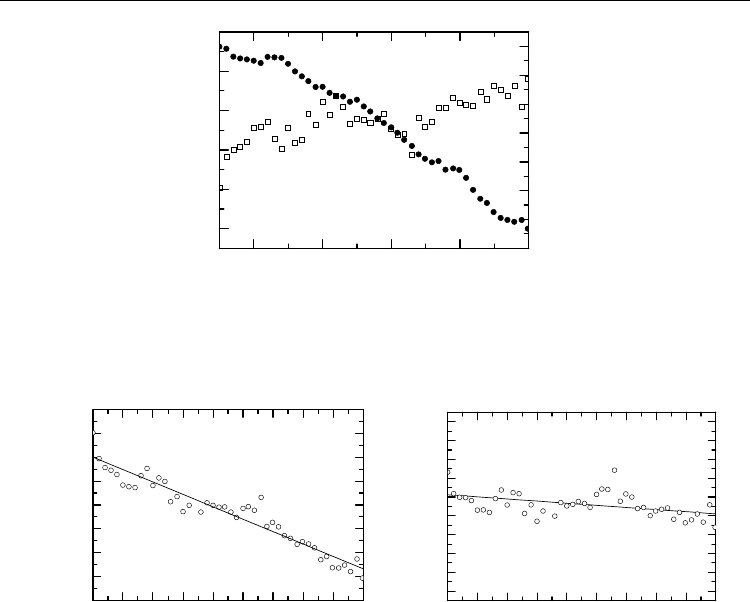
Ferroelectrics - Characterization and Modeling
294
30 40 50 60 70
1,016
1,018
1,020
1,022
1,024
1,026
Temperature (°C)
Normalized Amplitude
0,023
0,024
0,025
0,026
0,027
0,028
0,029
0,030
Normalized Phase (radians)
Fig. 4.4 Temperature evolution of the normalized amplitude (empty square) and phase (full
circle) of the PPE signal at 7.2Hz of a 510µm thick LiTaO
3
single crystal using ethylene
glycol as substrate.
25 30 35 40 45 50 55 60 65 70
1,20x10
-6
1,25x10
-6
1,30x10
-6
1,35x10
-6
1,40x10
-6
1,45x10
-6
1,50x10
-6
1,55x10
-6
1,60x10
-6
Thermal diffusivity (m
2
.s
-1
)
Temperature (°C)
25 30 35 40 45 50 55 60 65 70
2600
2800
3000
3200
3400
3600
3800
4000
4200
4400
Thermal effusivity (W.s
1/2
.m
-2
.K
-1
)
Temperature (°C)
Fig. 4.5 Temperature dependence of the thermal diffusivity and effusivity of LiTaO
3
as a
function of temperature, calculated from data of Fig. 4.3.
The two others thermal parameters, the volumic heat capacity C
p
and the thermal
conductivity k
p
can then be deduced. The knowledge of C
p
allows to extract the temperature
dependence of the pyroelectric coefficient γ, from the amplitude of the signal of the sample
alone, which is equivalent to the instrumental factor V
0
. In the expression of V
0
(Eq. 2.14),
only the ration
γ
/C
p
is temperature dependent, thus, multiplying V
0
by the values of C
p
and
scaling the result to a known value of γ at a given temperature, it is possible to obtain the
absolute value of the pyroelectric coefficient as a function of temperature. The results
obtained for LiTaO
3
are shown in Fig. 4.6 (the value of
γ
at 25°C was taken from Landolt-
Börnstein database (Bhalla and Liu, 1993)).
This subsection was dedicated to experiments in which the combination amplitude-phase of
the PPE signal gave information about the room temperature values and temperature
dependence of thermal parameters and pyroelectric properties of a ferroelectric material (in
position of pyroelectric sensor). Unfortunately, the use of the amplitude of the signal makes
the results rather noisy. Such a disadvantage can be avoided by using, when possible, only
data from the phase of the signal. In section 4.3.2, a procedure using the signal’s phase at
two frequencies will be presented, for studies of phase transitions.

Characterization of Ferroelectric Materials by Photopyroelectric Method
295
25 30 35 40 45 50 55 60 65 70
150
160
170
180
190
200
210
220
Pyroelectric coefficient (p) of LiTaO
3
(μC.m
-2
.K
-1
)
Temperature (°C)
Fig. 4.6 Temperature dependence of the pyroelectric coefficient of LiTaO
3
obtained from PPE
signal’s amplitude.
4.2 PPE detection of phase transitions in ferroelectric materials
As it is well known, phase transitions are processes associated with a breaking of the
symmetry of the system. In the case of ferroelectric materials, the ferro-paraelectric phase
transition has the polarization as order parameter and, theoretically, it is considered a
second order phase transition. Practically, sometimes it was found to be slightly first order
(a few amount of latent heat is developed in the process) (del Cerro et al., 1987). For both
type of phase transitions (I-st and II-nd order), the second derivatives of some appropriate
thermodynamic potential have anomaly at the transition temperature (Curie point for
ferroelectric materials). On the other hand, as presented in the theoretical section, the
amplitude and phase of the complex PPE signal depend on two (or sometimes one) sample’s
related thermal parameters. Consequently, it is expected that the PPE technique is suitable
to detect both first and second order phase transitions, by measuring the critical anomalies
of the thermal parameters.
In time, the PPE technique was applied to detect first (Mandelis et al., 1985) or second
(Marinelli et al.,1992) order phase transitions. For second order phase transitions the PPE
results were used to calculate the critical exponents of the thermal parameters and to
validate the existing theories (Marinelli et al., 1992, Chirtoc and al., 2009). Due to the fact
that the PPE technique uses for phase transition investigations the thermal parameters, a
wide range of materials belonging to condensed matter, can be listed as investigated
specimens: ordinary liquids and liquid mixtures, liquid crystals, liquid, pasty or solid
foodstuffs, ferroelectric and magnetic materials, high T
c
superconductors, plastics, etc
One of the most important points in making high-temperature-resolution measurements of
thermal parameters in the critical region of a phase transition is that the thermal gradients in
the investigated sample must be as small as possible. Often, at a phase transition, a strong
temperature dependence of the thermal parameters is present when approaching the critical
temperature. Thermal gradients tend to smear out this temperature dependence and,
sometimes, the phase transition is difficult to be detected. To avoid this effect, it is important
to keep the sample in quasi-thermal equilibrium. The measuring techniques, that in most
cases are based on the detection of a sample temperature rise, as a response to a heat input,
are additional sources of temperature gradients, especially for ac techniques. Accordingly,
the techniques involving periodic heating of the sample are preferred, and the PPE
technique is among them.
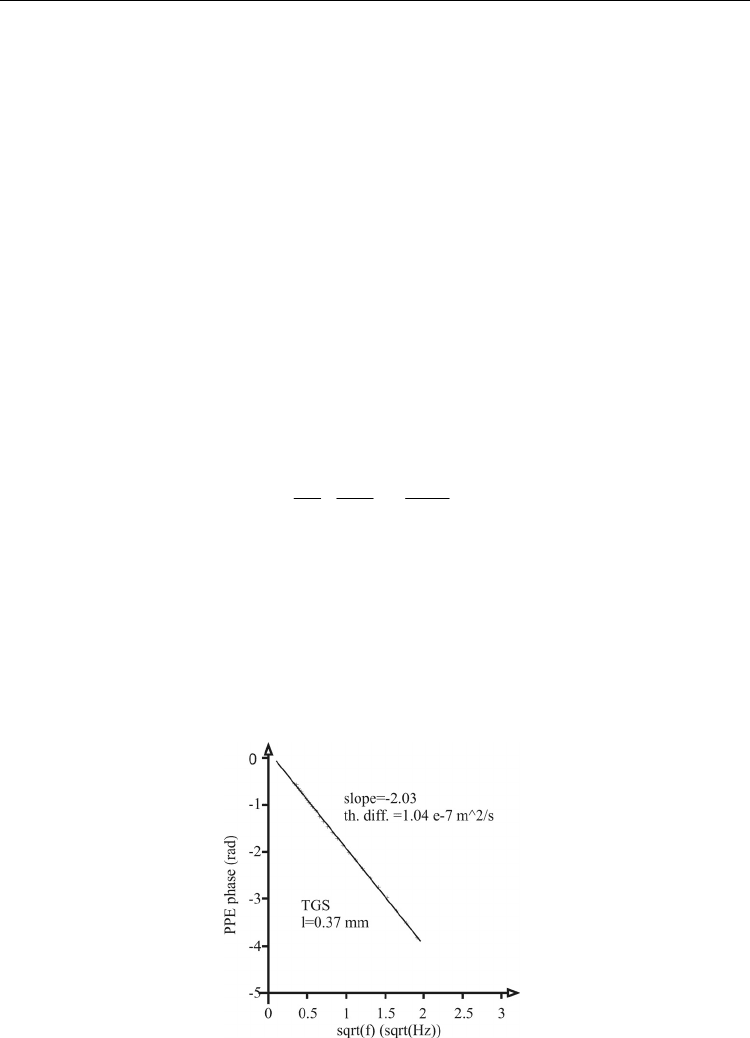
Ferroelectrics - Characterization and Modeling
296
Concerning the ferroelectric materials, Mandelis et al. used for the first time the PPE method
for detecting the ferro-paraelectric phase transition in Seignette salt (Mandelis et al., 1985).
In the following we will present an application of the PPE technique in detecting the
ferroelectric-paraelectric phase transition in a well known ferroelectric crystal, TGS.
4.2.1 TGS as a sample
When inserting a TGS crystal as sample in a PPE detection cell, one has to use the back (BPPE)
configuration, with the TGS crystal in the front position (directly irradiated), in intimate
thermal contact (through a thin coupling fluid) with a pyroelectric sensor (LiTaO
3
or PZT). In
experimental conditions of opaque and thermally thick sample and thermally thick sensor, the
amplitude, V, and phase, Θ, of the PPE signal are given by the Eqs. (2.7) and (2.8).
An inspection of Eqs.(2.7)-(2.8) leads to the conclusion that it is possible to obtain the
temperature behaviour of all four thermal parameters, from one measurement, if we have an
isolated value of one thermal parameter (other than thermal diffusivity), to calibrate the
amplitude measurement. Consequently, we can obtain the critical behaviour of all static and
dynamic thermal parameters around the Curie temperature of a ferroelectric material.
Some important features of Eq. (2.7) should be also stressed:
-
The amplitude of the PPE signal is attenuated by an exponential factor as a
m
L
m
increases;
-
The sensitivity of the signal amplitude to the changes in the thermal diffusivity is given
by the ratio:
2
/
mm
m
m
Lad
V
dV
−=
α
α
(4.9)
showing that for a
m
L
m
>2 , a given anomaly in the thermal diffusivity, produces an
enhanced signal anomaly;
-
For a given sample, the exponent in Eq. (2.7) can be adjusted by changing the
modulation frequency and/or sample’s thickness, in order to achieve an optimum
trade-off between sensitivity and signal-to-noise ratio.
Based on these theoretical predictions, one can start investigating the ferroelectric-
paraelectric phase transition of TGS crystal, by performing a room temperature frequency
scan of the phase of the PPE signal, in order to obtain the room temperature value of the
thermal diffusivity. A typical result is presented in Fig. 4.7.
Fig. 4.7 Room temperature frequency scan for the phase of the PPE signal
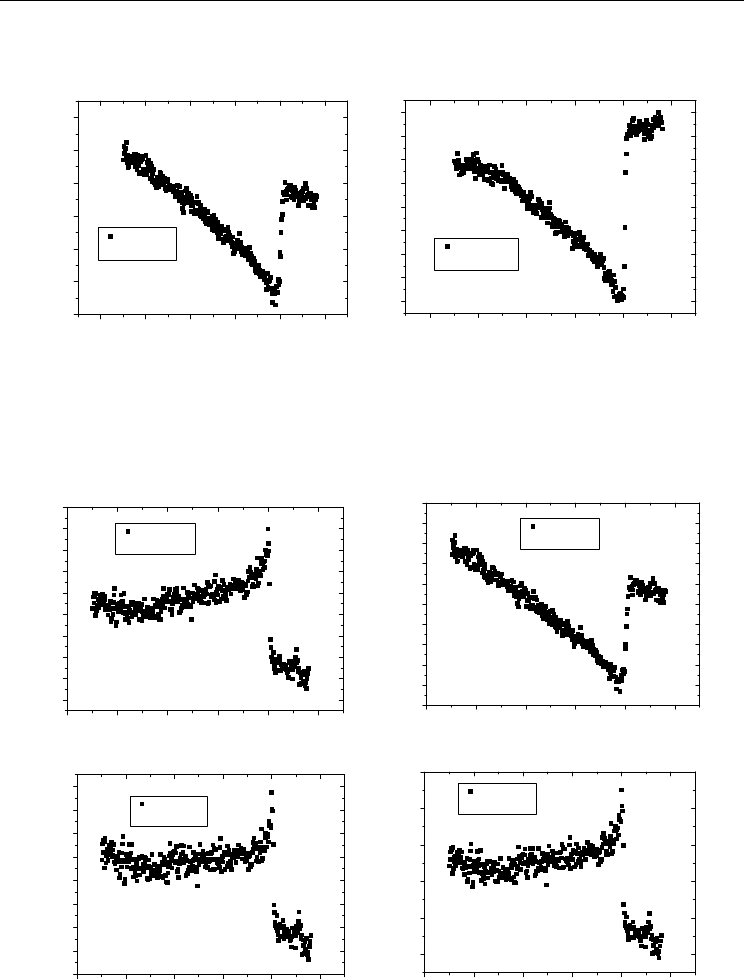
Characterization of Ferroelectric Materials by Photopyroelectric Method
297
Typical temperature scans of the amplitude and phase of the PPE signal, in a temperature
range including the Curie point of TGS are displayed in Fig.4.8
10 20 30 40 50 60
116
117
118
119
120
121
122
L
m
=370μm
f=0.3Hz
Temperature (°C)
PPE phase (deg.)
10 20 30 40 50 60
61
62
63
64
65
66
67
68
69
PPE amplitude (pA)
Temperature (°C)
L
m
=370μm
f=0.3Hz
Fig. 4.8 Temperature scan for the phase and the amplitude of the PPE signal
Using Eqs. (2.7)-(2.8), the value of the thermal diffusivity obtained from the slope of the
curve in Fig.4.7, and the value of the thermal conductivity from del Cerro et al., 1987, one
gets the critical behaviour of all four thermal parameters (Fig.4.9)
10 20 30 40 50 60
0.8
1.0
1.2
1.4
1.6
1.8
2.0
2.2
2.4
2.6
volume specific heat x10
6
(JK
-1
m
-3
)
temperature (°C)
L
m
=370μm
f=0.3Hz
10 20 30 40 50 60
0.92
0.94
0.96
0.98
1.00
1.02
1.04
1.06
1.08
1.10
1.12
thermal diffusivity x10
-7
(m
2
s
-1
)
Temperature (°C)
L
m
=370μm
f=0.3Hz
10 20 30 40 50 60
0.08
0.10
0.12
0.14
0.16
0.18
0.20
0.22
0.24
thermal conductivity (Wm
-1
K)
Temperature (°C)
L
m
=370μm
f=0.3Hz
10 20 30 40 50 60
300
400
500
600
700
800
thermal effusivity (Ws
1/2
m
-2
K
-1
)
Temperature (°C)
L
m
=370μm
f=0.3Hz
Fig. 4.9 Temperature behaviour of the volume specific heat, thermal diffusivity, conductivity
and effusivity of TGS around the Curie point
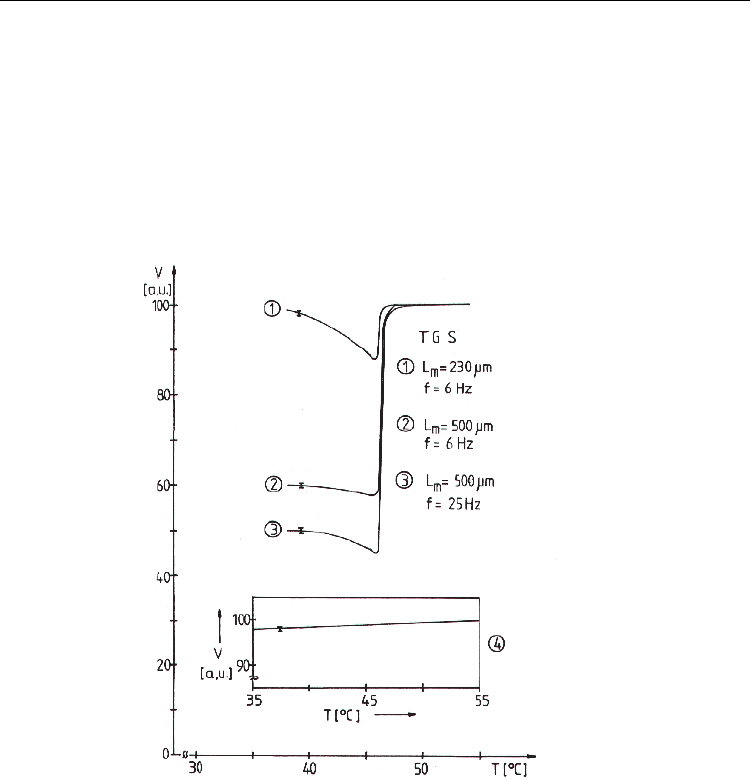
Ferroelectrics - Characterization and Modeling
298
Some technical details concerning the experiment are: TGS single crystal, 370µm thick,
pyroelectric sensor LiTaO
3
, 300µm thick, chopping frequency for the temperature scan
f = 0.3 Hz.
As mentioned above, one of the most important features concerning Eq. (2.7) is the
possibility of enhancing the critical anomaly of the thermal diffusivity, by a proper handling
of the chopping frequency and sample’s thickness.
Such an example, for a TGS crystal with two different thicknesses (230 µm and 500 µm),
investigated at different frequencies (6Hz and 25Hz) is displayed in Fig. 4.10. In this
experiment, the pyroelectric sensor was a 1mm thick PZT ceramic.
Fig. 4.10 Normalized PPE amplitude as a function of temperature for two TGS single
crystals and for two different chopping frequencies (different thermal diffusion length)
Fig. 4.10. indicates that the critical anomaly of the PPE amplitude, ΔV/V, increases from 0.14
up to 1.22 with increasing exponent in Eq. (2.7), for the same critical anomaly (about 0.2
jump in the specific heat – (del Cerro et al., 1987)). This fact supports the suitability of the
method for investigations of phase transitions with small critical anomalies of the thermal
parameters.
4.2.2 TGS as a pyroelectric sensor
This configuration is based on the information contained in the phase of the FPPE signal
and collected from a ferroelectric material, used as pyroelectric sensor in the PPE
detection cell.
